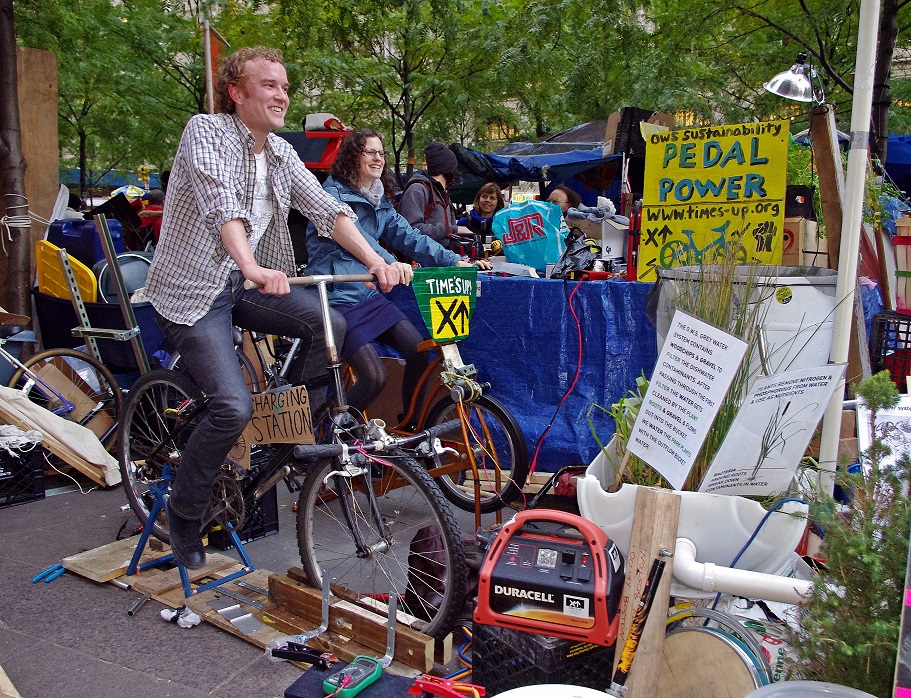Help needed: 41 servants and counting
an article about nature and technology
by Katie Singer
A few years ago, when I began questioning what it really takes to write and publish in our digital era, I wondered about electricity’s true costs. I learned that on average, in order to light, heat and cool our homes; to refrigerate and cook food; wash and dry laundry; keep hot water available; send emails, talk on phones, watch tv and videos, write on computers and publish and read posts online, U.S. households use 1000 kiloWatt hours (kWh) of energy per month.

Powering the average U.S. household needs 41 pedalers on bike-powered generators pedaling for eight hours each day.
Photo credit: David Shankbone
How much is 1000 kWh of power? The astrophysicist Adam Frank has explained that one able person can generate 24 kilowatt hours by pedaling a bike generator eight hours a day for 30 days. To generate 1000 kilowatt hours, 41 people would need to pedal eight hours a day for a month. In other words, for the average U.S. household, having electricity 24/7 means having 41 servants who pedal for you without a day off. [1]
But those 1000 kiloWatt hours do not include the energy involved in manufacturing my appliances or electronics.
This matters—because 81% of the energy used by a laptop from its cradle to its grave is embodied: 81% of a laptop’s lifetime energy will be used before the end-user turns that laptop on for the first time. [2]
Manufacturing every smartphone requires hundreds of substances, including plenty of extracted and smelted rare-earth metals, solvents and other chemicals, each with its own energy-intensive, greenhouse gas-emitting, toxic waste-emitting international supply chain. [3]
The Internet’s demands
Those 1000 kiloWatt hours of electricity average U.S. households use every month do not include the energy involved in maintaining the Internet’s infrastructure—the energy-guzzling, toxic waste emitting access networks (cables, satellites, routers, antennas, modems and battery backup systems) that let my computer transmit and receive data.
Those 1000 kiloWatt hours do not include the data centers (covered from floor-to-ceiling with servers and cooling systems) that store what I write. Data centers account for two percent of global greenhouse gas emissions. [4] The amount of energy consumed by data centers doubles every four years. [5]
Those 1000 kiloWatt hours do not include the energy used to discard or recycle my dysfunctional devices. At the end of their usable lives, electronics get shipped to dumpsites in Africa or Asia, where they may be burned to access copper, for example. Electronic waste impacts soil, water, air—and living creatures’ health. Electronics do not biodegrade. They are hazardous waste.
Pedaling for the Internet
How many servants does it take to run the Internet (and access this article)? The late corporate anthropologist Jane Anne Morris calculated that 4.8 billion people pedaling for six hour each day could generate enough power to operate the 2010 worldwide Internet. [6] (Pedalers can look at read online while they pedal.)
Since 2010, the number of Internet users has more than doubled to 4.66 billion. [7] Gosh. We don’t yet have nine billion pedalers available. To keep 2021’s World Wide Web going, we’ll need to increase the number of hours per bike pedaling shift.
I should note that neither Frank nor Morris calculated the energy or extractions embodied in manufacturing or discarding billions of bicycle powered-generators and batteries.
I should note that with billions of people focused on pedaling to keep lights and appliances running, we might drastically reduce our production and consumption of unnecessary manufactured goods.
Preparing for change
I grew up with electricity and appliances. I’ve had a computer for 35 years, Internet access for more than two decades. I do not know how to survive without these things: I depend on unsustainable infrastructure and international supply chains.
If my state has an electric power outage for several weeks (like Texas had last February)[8]—if our thermostats, stoves, hot water heaters, refrigerators, washing machines, phones and computers stopped working—how would my neighbors and I survive? What tools would we use?
To prepare for power outages, should we take out our grandparents’ washboards, hacksaws and canning equipment? Should we build raised beds with insulating covers and dig root sellers? Should we each aim to reduce our consumption (watch your credit card and utility bills) by three percent per month? Or, should we all quit our jobs and start biking?
Postscript
After reading this piece, Tom Troszak, the industrial process designer who has taught most of what I report about manufacturing silicon for transistors and solar panels’ wafers [9], wrote me the following note:
Averaging the daily power output of 41.6 cyclists over a month is a mistake. Capturing—and doling out—the power generated by 41.6 people cycling eight hours per day would only work if the bicycles, generators, batteries and inverters were all 100% efficient and required no energy to make. Such technology will never exist.
Realistically, to have electricity available 24/7 (without battery backup) you’d need 240 very fit cyclists. Per day, each of them would pedal one of three eight-hour shifts. You’d have 80 cyclists each shift.
Even then, 80 cyclists pumping like mad could not meet a typical home’s PEAK 12 kW evening load. The evening shift would need 120 cyclists.
I therefore estimate that the average U.S. household needs 280 bike slaves. To allow subs to ride in for meal and toilet breaks, round up this number to 300.
Do note: if you feed the cyclists, the food’s caloric value is 10X greater than the power they produce. Therefore, we need to calculate the energy input of farming the carbs they will burn. Also, even if each bike generator lasted for 30 years, the total power pedaled out during those three decades would hardly equal the energy used in manufacturing the bikes and generators alone. Globally speaking, bike generators do not produce any surplus energy.
In other words, don’t ask how many slaves you need to power your house. Ask how many slaves you need to power a bicycle factory, a generator factory, a large farm, a walk-in refrigerator, a few chefs, a clothing factory and a laundromat. You’ll also need a dormitory to house these 80 cyclists so they don’t have to live with you.
You’ll need more cyclists to power their dorm.
Let’s get real: a ratio of 300 slaves per household is risky. What if any one of your 300 slaves decided that they wanted their own home (powered by 300 more cyclists)?
Now you see the problem: “powering your home with 41 cyclists” is not just impossible. It’s exponentially impossible, forever.
REFERENCES:
- “Could You Power Your Home with a Bike?” Adam Frank on NPR, December 8, 2016. https://www.npr.org/transcripts/504790589
- https://spectrum.ieee.org/energy/environment/your-phone-costs-energyeven-before-you-turn-it-on
- Needhidasan, S., et al., “Electronic waste–an emerging threat to the environment of urban India,” J. Environ Health Sci. Eng., Jan. 20, 2014; http://www.ncbi.nlm.nih.gov/pmc/articles/PMC3908467.
- https://theguardian.com/environment/2015/sep/25/server-data-centre-emissions-air-travel-web-googleface-book-greenhouse-gas
- https://www.independent.co.uk/environment/global-warming-data-centres-to-consume-three-times-as-much-energy-in=next-decade-experts-warn-a6830086.html
- http://democracythemepark.org/bicycle-powered-internet/
- https://www.statista.com/statistics/617136/digital-population-worldwide/
- https://en.wikipedia.org/wiki/2021_Texas_power_crisis
- “Why do we burn coal and trees to make solar panels?” by Thomas Troszak. https://www.researchgate.net/publication/335083312_Why_do_we_burn_coal_and_trees_to_make_solar_panels
Katie Singer writes about the energy, extractions, toxic waste and greenhouse gases involved in manufacturing computers, telecom infrastructure, electric vehicles and other electronic technologies. She believes that if she’s not aware that she’s part of the problem, then she can’t be part of the solution. She dreams that every smartphone user learns about the supply chain of one substance (of 1000+) in a smartphone. Her most recent book is An Electronic Silent Spring. She currently writes about nature, democracy and technology for Meer.com. Visit www.OurWeb.tech and www.ElectronicSilentSpring.com.
This article was originally published by Meer.com.
